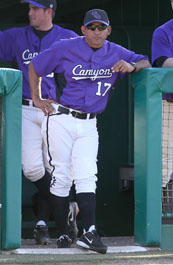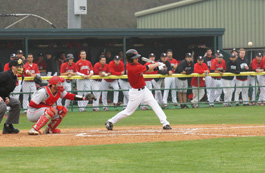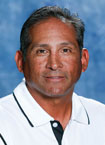February 14, 2014
Two Schools Ready to Make Impact
at D-I Level
By Zach DiSchiano
CollegeBaseballInsider.com
 The University of the Incarnate Word and Grand
Canyon University are almost 1,000 miles apart from each other,
but the two schools share common ground: Both baseball programs
are entering their first year of Division I play in 2014. The University of the Incarnate Word and Grand
Canyon University are almost 1,000 miles apart from each other,
but the two schools share common ground: Both baseball programs
are entering their first year of Division I play in 2014.
Incarnate Word, located in San Antonio, and Grand
Canyon, based in Phoenix, are well equipped to handle their
first years against the NCAA’s premier talent behind the
direction of coaches Danny Heep and Andy Stankiewicz (pictured
above).
The two combined for 23 seasons of experience in
Major League Baseball, and their time spent in the pros commands
respect from their players.
“It’s awesome, just ‘cause you know everything
he’s saying is the correct way to do things on a baseball
field,” Grand Canyon first baseman Michael Pomeroy said of
Stankiewicz. “Whether it’s hitting, whether it’s defensively,
whether it’s pitching, you know that when he says something, you
need to listen, and you need to soak it in.”
 The MLB experience from their coaches provides a
unique insight for the players. Jason Stone (right), a senior outfielder
for Heep’s Cardinals, said his coach alludes to stories from his
days in the big leagues to help relate to the players. The MLB experience from their coaches provides a
unique insight for the players. Jason Stone (right), a senior outfielder
for Heep’s Cardinals, said his coach alludes to stories from his
days in the big leagues to help relate to the players.
“He will tell a story every now and then about
how he wasn’t the biggest, he wasn’t the strongest, he wasn’t
the fastest,” Stone said. “Everyone kept doubting him, but he
was really successful at the highest level. So it kind of
inspires us.”
 During his 12-year tenure in the majors, Heep
(left)
recorded 503 hits and 229 RBI on five different teams, winning
two World Series with the New York Mets in 1986 and the Los
Angeles Dodgers in 1988. Since taking over as head coach for
Incarnate Word in 1998 – and playing in Division II since 2000 –
Heep has won 530 games and two conference championships. During his 12-year tenure in the majors, Heep
(left)
recorded 503 hits and 229 RBI on five different teams, winning
two World Series with the New York Mets in 1986 and the Los
Angeles Dodgers in 1988. Since taking over as head coach for
Incarnate Word in 1998 – and playing in Division II since 2000 –
Heep has won 530 games and two conference championships.
But 2014 will be an entirely new challenge for
the accomplished coach. Heep scheduled multiple series against
power conference teams, including Oklahoma State to start the
year, with games later in the season against Notre Dame, Gonzaga
and Baylor.
“We’re going into every game like we’re going to
win them all,” Heep said. “But we know what reality is, and we
know this is a process. But our players are working hard.”
Colton Besett, Heep’s starting catcher, said he
is aware of the challenges the team will face in its initial
year at the Division I level.
“Every game we play this year, we’re pretty much
going to be the underdogs,” he said. “No one is expecting us to
win. When we go to play Oklahoma State, they’re going to look
like the Yankees, except they’re going to be in orange and
black. There’s going to be adrenaline running, for sure. We have
nothing to lose.”
 The challenge of adjusting to the next level of
play starts off the field, in the messy world of recruiting.
Stankiewicz (left), who played 429 games over seven Major League
seasons, coached Single-A ball and assisted at Arizona State,
said recruiting becomes easier in some ways but more difficult
in others. The challenge of adjusting to the next level of
play starts off the field, in the messy world of recruiting.
Stankiewicz (left), who played 429 games over seven Major League
seasons, coached Single-A ball and assisted at Arizona State,
said recruiting becomes easier in some ways but more difficult
in others.
“It’s easier in a way that a lot of kids are
calling us back now because we’re a Division I program,” he
said. “The difficult part now is we’re competing against, in the
state of Arizona, ASU
[Arizona
State] and U of A [Arizona], pretty good programs, obviously.
That’s the tough part. You’re excited about Division I, but now
you got to rub shoulders with the big boys.”
Establishing a presence amongst the nation’s top
programs is exceedingly difficult, Heep said, mainly because
kids grow up dreaming of playing for teams like Texas, Rice,
Texas A&M and TCU. His coaching staff has to get creative in the
way they recruit athletes because their facilities are not state
of the art like those of surrounding schools, and the name
recognition is not there.
Financial considerations also play an important
factor in landing some of the more talented recruits, Heep said.
Players who are not getting as much money to play for a big-name
school will have the opportunity to pick up more financial aid
at a small program like Incarnate Word.
“Some kids might not be getting a lot of
scholarships at Texas or A&M or TCU,” he said. “They’re getting
the minimum 25 percent, and Mom and Dad have to come up with 20
grand, and we’re offering these guys 75-80 percent, it puts a
little thought in their process about where they want to go to
school.”
Heep said the great thing
about baseball is the overwhelming amount of talent up for
grabs. Roster-size limits prevent the powerhouses from hoarding
all the good players, which allows for smaller schools to sign
talented players who may not be elite enough to make a 35-man
team at a school like Texas or Texas A&M.
“You do not have to have the top-20 kids in the
country to be a good team,” he said. “There’s a ton of kids out
there that are capable of being good Division I players. You
just have to do your homework, and you got to work at it. You
got to go look.”
Jorge Perez, Grand Canyon’s ace pitcher, will
face his fair share of top-20 level talent every Friday
throughout the season. The shift in hitting ability from
Division II to Division I, he said, is clearly noticeable.
“They have a little more power, more discipline
at the plate,” Perez said. “So I just got to pitch smart and
make sure I don’t give away any mistake pitches. Keep hitting
your spots and you should be fine, they’re going to get
themselves out.”
Both the Lopes and the Cardinals may be underdogs
for nearly every game they play this season, but the players
have embraced the challenge and are eager to play Division I
opponents.
“We can’t wait to get on our plane ride for
Friday’s first opener,” Pomeroy said. “We’re very excited to
show D-1 what we’re made of.”
With Oklahoma State on the schedule first for
Incarnate Word, some of the Cardinals players have reason to be
intimidated. Heep said that is simply not the case.
“They better not be,” he said, with a laugh. “I’m
not.”
(photos courtesy of GCU & UIW Media
Relations)
|